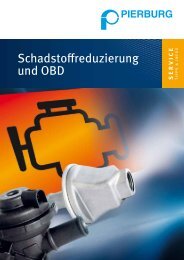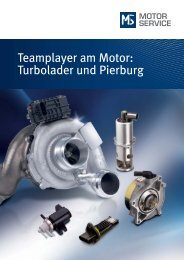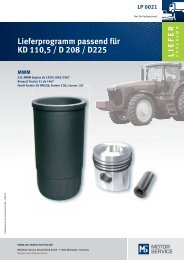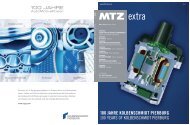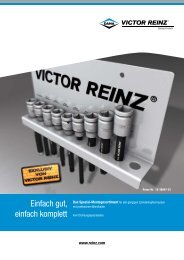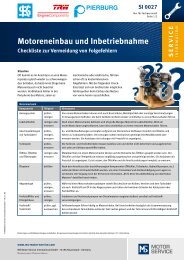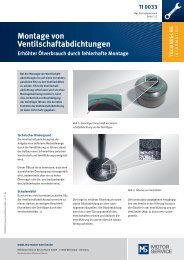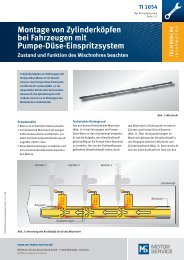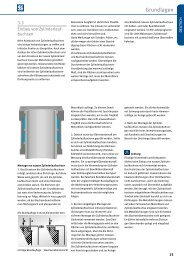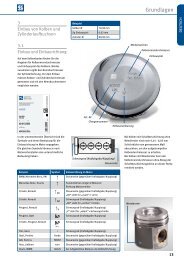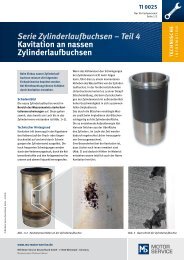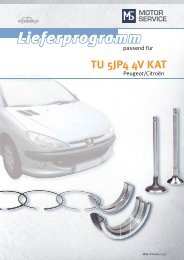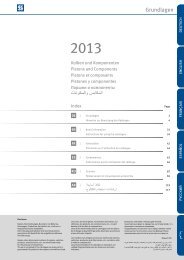Turbolader - MS Motor Service Deutschland GmbH
Turbolader - MS Motor Service Deutschland GmbH
Turbolader - MS Motor Service Deutschland GmbH
Create successful ePaper yourself
Turn your PDF publications into a flip-book with our unique Google optimized e-Paper software.
» Wichtig für Ihren Sachmängelhaftungsanspruch<br />
Nichtbeachtung der Einbauvorschriften hat den Verlust<br />
sämtlicher Sachmängelhaftungsansprüche zur Folge.<br />
Vor der Montage unbedingt lesen!<br />
» Important: This is essential for your claims<br />
with regard to liability for material defects.<br />
Non-observance of the installation instructions will<br />
result in the loss of all claims with regard to liability<br />
for material defects.<br />
Please read these instructions before starting installation!<br />
» Important pour vos revendications de vices cachés<br />
Le non respect des prescriptions de montage entraîne<br />
la perte de tout droit de revendication pour vice caché.<br />
A lire impérativement avant le montage !<br />
» Importante para sus exigencias en cuanto<br />
a la garantía de fallos técnicos.<br />
La no observancia de las indicaciones de montaje tiene<br />
por consecuencia la pérdida de todas las garantías de<br />
fallos técnicos.<br />
¡Indispensable leer antes de efectuar el montaje!<br />
<strong>MS</strong> <strong>Motor</strong> <strong>Service</strong> <strong>Deutschland</strong> <strong>GmbH</strong> 12/2011
Umfeld des <strong>Turbolader</strong>s – bei Beanstandungen prüfen!<br />
Adjacent parts of turbocharger – check in the event of claims!<br />
Pourtour du turbo compresseur – à contrôler en cas de réclamation !<br />
¡Inspeccione el entorno del turbocompresor en caso de reclamaciones!<br />
Ladedruck-Regelventil (EUV)<br />
Boost pressure control valve (EUV)<br />
Soupape de régulation de la pression de suralimentation<br />
(EUV)<br />
Válvula reguladora de la presión de carga (EUV)<br />
Pneumatischer Steller<br />
(„Druck-/Unterdruckdose“)<br />
Pneumatic actuator (Pressure/<br />
vacuum box)<br />
Actionneur pneumatique (« capsule<br />
de pression/ dépression »)<br />
Regulador neumático („caja de<br />
presión/ depresión“)<br />
Vakuumpumpe<br />
Vacuum pump<br />
Pompe à vide<br />
Bomba de vacío<br />
Unterdruckspeicher<br />
Vacuum reservoir<br />
Chambre à dépression<br />
Acumulador de vacío<br />
Druckwandler (EPW)<br />
Pressure converter (EPW)<br />
Convertisseur de pression<br />
(EPW)<br />
Convertidor de la presión<br />
(EPW)<br />
VTG-Lader<br />
VTG charger<br />
Turbocompresseur à ailettes à géométrie variable<br />
Cargador VTG<br />
<strong>Turbolader</strong> mit Wastegate-Klappe<br />
Turbocharger with waste gate valve<br />
Turbocompresseur avec soupape de décharge<br />
Turbocargador con chapaleta Wastegate<br />
Pneumatischer Steller („Druck-/Unterdruckdose“)<br />
Pneumatic actuator (Pressure/vacuum box)<br />
Actionneur pneumatique (« capsule de<br />
pression/ dépression »)<br />
Regulador neumático („caja de presión/<br />
depresión“)<br />
Bei Beanstandungen, die auf den<br />
Turbo lader als Fehlerquelle hinweisen,<br />
müssen auch immer die Bauteile<br />
im Umfeld überprüft werden.<br />
Mögliche Beanstandungen:<br />
Leistungsverluste, Ruckeln, Schwarzrauch,<br />
Fahrzeug geht in Notlauf<br />
Bei den oben angegebenen Beanstandungen wird<br />
der Fehler oft dem <strong>Turbolader</strong> zugeschrieben.<br />
Mögliche Ursachen können aber auch sein:<br />
• Defekte elektropneumatische Ventile<br />
• Eine Vakuumpumpe, die zu wenig Unterdruck<br />
liefert<br />
• Leckagen im Unterdrucksystem<br />
Prüfung<br />
Zur Prüfung von elektropneumatischen Ventilen<br />
siehe folgende Pierburg <strong>Service</strong> Informationen<br />
(SI):<br />
EUV: SI 0050, SI 0051<br />
EPW: SI 0065, SI 0076<br />
En cas de réclamations qui incriminent<br />
le turbocompresseur comme source<br />
du défaut, il faut aussi toujours<br />
contrôler les composants dans son<br />
environnement.<br />
Réclamations possibles :<br />
chutes de puissance, à-coups, fumée noire,<br />
véhicule passe en fonctionnement d‘urgence<br />
Dans le cas des réclamations mentionnées<br />
ci-dessus, le défaut est fréquemment imputé<br />
au turbocompresseur.<br />
Mais des causes possibles peuvent aussi être :<br />
• des soupapes électropneumatiques défectueuses,<br />
• une pompe à vide qui engendre une dépression<br />
insuffisante,<br />
• des fuites dans le système de dépression.<br />
Contrôle<br />
Pour contrôler les soupapes électropneumatiques,<br />
voir les Informations de service<br />
Pierburg (SI) suivantes :<br />
EUV : SI 0050, SI 0051<br />
EPW : SI 0065, SI 0076<br />
In the case of complaints which point<br />
to the turbocharger being at fault,<br />
always the components around it<br />
must also be checked.<br />
Possible complaints:<br />
power loss, jerkiness, black smoke, vehicle<br />
reverts to emergency mode<br />
In the case of the complaints listed above, the<br />
fault is frequently attributed to the turbocharger.<br />
But possible causes may also be:<br />
• defective electropneumatic valves<br />
• a vacuum pump delivering an insufficient<br />
vacuum<br />
• leakage in the vacuum system<br />
Check<br />
For checking electropneumatic valves, see the<br />
following editions of Pierburg <strong>Service</strong> Information<br />
(SI):<br />
EUV: SI 0050, SI 0051<br />
EPW: SI 0065, SI 0076<br />
Caso de reclamaciones que refieren<br />
al turbocargador como causa del fallo<br />
deben también verificarse los componentes<br />
del entorno.<br />
Posibles reclamaciones:<br />
Pérdidas de potencia, Tirones, Humo negro,<br />
Vehículo conmuta a marcha de emergencia<br />
Frecuentemente, en el caso de las reclamaciones<br />
anteriormente relacionadas, se atribuye<br />
la causa al turbocargador.<br />
Posibles causas, sin embargo, también pueden<br />
ser:<br />
• Válvulas electroneumáticas averiadas.<br />
• Una bomba de vacío que genera muy poca<br />
depresión.<br />
• Fugas en el sistema de vacío.<br />
Comprobación<br />
Para la comprobación de válvulas electroneumáticas<br />
consúltense las siguientes Informaciones<br />
de servicio Pierburg (SI):<br />
EUV: SI 0050, SI 0051<br />
EPW: SI 0065, SI 0076
Bei Nichtbeachtung<br />
erlischt Sachmängelhaftung!<br />
Le droit de revendication pour vice<br />
caché expire en cas de non respect<br />
Einbauvorschriften für die Montage des <strong>Turbolader</strong>s<br />
Achtung! Beachten Sie für den Einbau die Reparaturanleitung des <strong>Motor</strong>enherstellers und<br />
folgende allgemeine Hinweise:<br />
• Prüfen Sie die Ausfallursache des zu ersetzenden <strong>Turbolader</strong>s.<br />
• Prüfen bzw. reinigen Sie die Ansaugleitung und das Abgassammelrohr des <strong>Motor</strong>s. Fremdkörper<br />
in den Leitungen verursachen mit Sicherheit Schäden bei der Inbetriebnahme.<br />
• Die Ölzulaufleitung und die Ölablaufleitung sind ebenfalls zu prüfen bzw. zu reinigen.<br />
Im Zweifel sind die Leitungen zu ersetzen.<br />
• Überprüfen Sie vor der Montage die Luft-Ölfilteranlage des <strong>Motor</strong>s, nehmen Sie einen Luftfilterwechsel<br />
und Ölwechsel mit Filter vor. Verwenden Sie nur vom Hersteller freigegebenes <strong>Motor</strong>enöl.<br />
• Füllen Sie die Öleinlassbohrung des <strong>Turbolader</strong>s mit sauberem <strong>Motor</strong>öl, damit eine einwandfreie<br />
Schmierung bei der Inbetriebnahme gesichert ist.<br />
• Neuen Anbausatz verwenden.<br />
• Bei allen Anschlüssen am <strong>Turbolader</strong> nie flüssiges Dichtmittel verwenden.<br />
• Starten Sie den <strong>Motor</strong> und lassen Sie diesen ca. 30 Sekunden im Leerlauf laufen, bevor Sie<br />
ihn belasten.<br />
Instructions de montage du turbo compresseur<br />
Attention ! Au montage, veuillez respecter les instructions de réparation du fabricant du moteur<br />
ainsi que les recommandations générales suivantes :<br />
• Veuillez vérifier la cause de la panne du turbo compresseur à remplacer.<br />
• Vérifiez et, au besoin, nettoyez la conduite d’admission et le collecteur d’échappement du moteur.<br />
Tout corps étranger dans une conduite provoque automatiquement des dégâts à la mise en service.<br />
• Les conduites d’alimentation et de refoulement d’huile sont également à contrôler et<br />
à nettoyer. En cas de doute, les conduites doivent être remplacées.<br />
• Avant le montage, contrôlez les circuits d’air et d’huile du moteur, procédez à un échange<br />
du filtre à air, faites la vidange et changer également le filtre à huile. Utilisez uniquement<br />
l’huile de moteur homologuée par le fabricant.<br />
• Remplissez l’orifice de remplissage d’huile du turbo compresseur avec une huile de moteur<br />
propre, de manière à assurer une bonne lubrification dès la mise en service.<br />
• Utilisez le nouveau kit de montage.<br />
• Ne jamais utiliser un produit d’étanchéité liquide sur les raccordements du turbo compresseur.<br />
• Démarrez le moteur et laissez le tourner environ 30 secondes avant de le monter en charge.<br />
Loss of all claims with regard to<br />
liability for material defects in the<br />
event of non-observance.<br />
En caso de no observancia<br />
extingue la garantía de fallos<br />
técnicos.<br />
Instructions for installing turbochargers<br />
Attention! During the installation process, the repair instructions issued by the engine<br />
manufacturer and the following general guidelines must be observed:<br />
• Check the cause of failure of the turbocharger to be replaced.<br />
• Check or clean the suction line and the exhaust manifold of the engine. Foreign material in the<br />
lines is certain to cause damage during start-up.<br />
• Check or clean the oil supply and the oil drain line as well. In cause of doubt, the lines should<br />
be replaced.<br />
• Check the air/oil filter system of the engine prior to installation, replace air filter and perform<br />
an oil change with oil filter replacement. Only motor oil that has been approved by the<br />
manufacturer should be used.<br />
• Fill the oil inlet hole of the turbocharger with clean engine oil to ensure a perfect lubrication<br />
during start-up.<br />
• Please use a new attachment kit.<br />
• Never use a liquid sealant when establishing connections to the turbocharger.<br />
• Start the engine and allow it to idle for about 30 seconds before subjecting it to strain.<br />
Normas para el montaje del turbocargador<br />
¡Atención! Siga las instrucciones contenidas en el manual de reparaciones del fabricante<br />
automotriz y las indicaciones generales mencionadas a continuación para efectuar el montaje:<br />
• Compruebe la causa de la avería del turbocargador que será cambiado.<br />
• Inspeccione o limpie el tubo de aspiración y el tubo colector de gases de escape del motor.<br />
Las partículas extrañas contenidas en las tuberías ocasionan con seguridad daños a la hora<br />
de la puesta en marcha.<br />
• Inspeccione o limpie también el tubo de alimentación de aceite y el de drenaje. Cambie el<br />
tubo en casos dubiosos.<br />
• Inspeccione antes del montaje el sistema de filtración de aceite y aire del motor; cambie el filtro de<br />
aire y el aceite con un filtro. Use solamente el aceite para motores autorizado por la empresa fabricante.<br />
• Llene el orificio de entrada de aceite del turbocompresor con un aceite motriz limpio a fin de<br />
obtener una buena lubricación cuando el vehículo sea puesto en marcha.<br />
• Use el set de piezas nuevas adicionales.<br />
• Nunca utilice agentes obturadores líquidos en ninguna de las conexiones del turbocargador.<br />
• Arranque el motor y déjelo en marcha en ralentí durante unos 30 segundos antes de someterlo<br />
a esfuerzos.
<strong>Turbolader</strong><br />
Diagnose Matrix<br />
Art der Störung<br />
Mögliche Ursachen<br />
Mangelnde Ölversorgung des <strong>Turbolader</strong>s<br />
Ungeeignetes <strong>Motor</strong>enöl / mangelnde Ölpflege<br />
Fremdpartikel im <strong>Motor</strong>enöl<br />
Fremdkörper im Verdichter- oder Turbinengehäuse<br />
Kurbelgehäuseentlüftung oder Ölrücklaufleitung verstopft oder defekt<br />
Ventilführungen, Kolbenringe, <strong>Motor</strong> oder Zylinderlaufbuchsen verschlissen / erhöhtes Blow By<br />
Luftfilter verstopft / Saug- oder Druckleitungen undicht<br />
Abgasleckage vor oder nach dem Turbinengehäuse<br />
Abgasanlage hat zu hohen Strömungswiderstand<br />
Ladedruckregelklappe / Ventil öffnet oder schließt nicht<br />
VTG in der Bewegung eingeschränkt<br />
Ansteuerung der Regelklappe / Ventil / VTG-Einheit defekt<br />
Elektrische / elektronische Regeleinheit des Tuboladers defekt<br />
Kraftstoffanlage / Einspritzanlage defekt oder falsch eingestellt<br />
<strong>Turbolader</strong> mit Überdrehzahl<br />
Verdichter- / Turbinenrad defekt<br />
x<br />
Ladedruck zu niedrig x x x x x x x x x<br />
Ladedruck zu hoch x x x x x x<br />
<strong>Turbolader</strong> erzeugt Geräusche x x x x x x x<br />
Schwarzrauch x x x x x x<br />
Blaurauch x x x x x x x x<br />
Hoher Ölverbrauch x x x x x x x x<br />
Ölleckage im Verdichtergehäuse x x x x x x x<br />
Ölleckage im Turbinengehäuse x x x x x x x<br />
<strong>Turbolader</strong> überhitzt x x x x x x x<br />
Erhöhtes Wellenspiel axial / radial x x x x<br />
Fehlermeldung im <strong>Motor</strong>management x x x x x x x x x x<br />
Zentralmutter gelöst / fehlt x x



